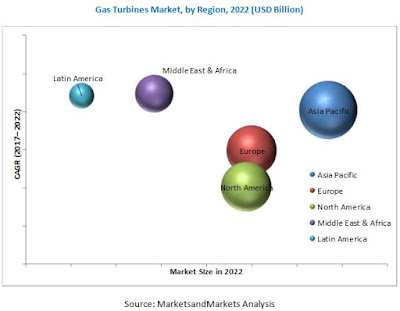The offshore
wind market is expected to grow
from an estimated USD 27,019.1 million in 2017 to USD 55,109.6 million by 2022,
registering a CAGR of 15.32% from 2017 to 2022. The global
market is witnessing significant growth due to rising energy demand coupled
with increasing share of renewables in the power generation mix, regulations
on energy efficiency, growing trend of industrialization and increased
urbanization, regulations to ensure efficiency and utilization of energy.
The shallow water
segment is expected to hold the largest share of the offshore wind market, by
location, during the forecast period.
Among the three-water depth location for offshore
wind turbines, shallow water is expected to hold the largest share during the
forecast period. The development of shallow water is generally cost effective
due to better weather conditions, whereas, installing wind turbines in deep
water becomes expensive due to high maintenance cost. However, offshore wind turbines are getting
installed in all three water locations depending on the region, turbine
capacity, and wind speed. Shallow water condition mostly prevails in the
European countries due to favorable weather conditions. The major players that provide turbines
which can be installed in shallow water includes Siemens AG (Germany) and MHI
Vestas (Denmark), among others.
Download PDF Brochure @ https://www.marketsandmarkets.com/pdfdownloadNew.asp?id=253452593
The electrical
infrastructure segment is expected to be the fastest growing offshore wind
market, by component, during the forecast period.
The electrical infrastructure segment is expected
to account for the highest CAGR during the forecast period. The growth of this
segment can be attributed to the growth of offshore substation, land-based
transmission infrastructure, and cables and accessories related to the offshore
wind turbines. Offshore substation controls the electric system of the turbine
and increases the voltage of electricity produced by the wind turbines to
reduce electrical losses. Land-based transmission infrastructure includes
onshore transmission or conversion equipment, required to connect the wind farm
project to the power grid. The last most important component of an electrical
infrastructure is the cable and are primarily of two types, namely, inter-array
cables and export cables. Inter-array cables connect the turbines to the
offshore substation while the export cables are used to transmit the power from
offshore substation to the onshore substation and power grid.
Asia Pacific: The second largest market for
offshore wind.
This region is expected to grow at second position
followed by Europe due to its growing trends such as increasing urbanization
and industrialization which is leading to higher demand in the power sector.
The countries are focusing on power generation through renewable energy sources
and offshore wind forms an integral part of renewable based power generation.
Technological advancement and clean energy consumption would further propel
wind power deployment and open up opportunities in emerging markets in
Asia-Pacific, especially in countries like China, Japan, and South Korea as
they are looking for alternative source of energy to diversify their energy mix
to reduce CO2 emission. The other major drivers include strict government
regulations on energy efficiency.
Request Sample Pages of the Report @ https://www.marketsandmarkets.com/requestsampleNew.asp?id=253452593
Some of the leading players in the offshore wind
market includes Siemens AG (Germany), ABB Ltd. (Switzerland), MHI Vestas (Denmark), General Electric
(U.S.), EEW Group (Germany), A2Sea (Denmark), Nexans (France), among others.
Scope of the Report
This study estimates the global market for offshore
wind, in terms of USD, till 2022. It also offers a detailed qualitative and
quantitative analysis of the market. The report provides a comprehensive review
of the major market drivers, restraints, opportunities, challenges, winning
imperatives, and key issues. It also covers various important aspects of the
market. These include an analysis of the supply chain, a competitive landscape,
market dynamics, market estimates in terms of value, and future trends in the offshore wind market.

